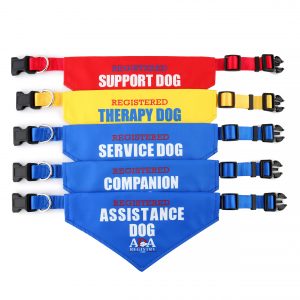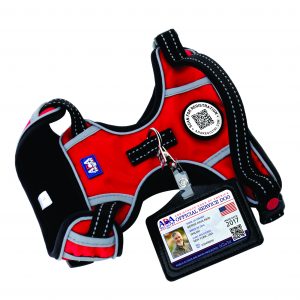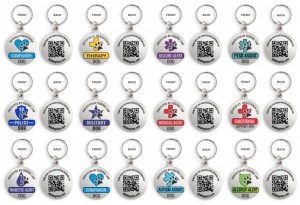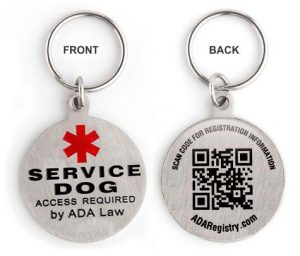Reunited With Service Dog
Three years after escaping from a fenced in yard in an unfamiliar city, Lola the black Labrador is back laying on the couch with her mom Debra Mejeur in Kalamazoo.
Mejeur has been waiting for this day since Lola ran away in October 2017. After spending years navigating outside on her own and relying on the kindness of strangers, it was nothing short of an early Christmas miracle that Lola was returned to her family on Saturday, Dec. 5.
In the yard in front of the animal shelter Lola was timid at first and hid behind the vet. She gave Mejeur a few sniffs and one big lick on the forehead before her tail started wagging wildly and she burrowed into Mejeur for a hug. When she noticed Mejeur’s husband, Lola bounded over to him knocking him to the ground with excitement.
China Guide Dogs
As the Chinese economy has grown into the second largest in the world, the country lags far behind in another marker – the availability of guide dogs for the blind.
There are less than 300 guide dogs in China for 17,300,000 visually-impaired people, leaving less than 0.001% of people with access to a guide dog, according to the Zhengzhou Love Guide Dog Service Center, a guide dog training school.
This compares to the United States where the Centers for Disease Control and Prevention estimates there are 1.02 million blind people. According to Guiding Eyes for the Blind there are about 10,000 guide dogs for the blind. That means about 1% blind people have guide dogs – 1000 times the ratio of China.
Other places have varying rates:
The United Kingdom. The Guide Dogs for the Blind Association says there are currently 5,000 active guide dogs for 2 million living with sight loss – a rate of 0.25%.
Germany. According to a recent article in Die Zeit’s there are 180,000 blind people in Germany, and 2,700 guide dogs in service, meaning the 1.5 percent of the blind have guide dogs.
Japan has 909 guide dogs with 320,000 registered blind people as of 2020, according to The Japan Guide Dog Association. That means 0.28% of blind people own a guide dog.
Taiwan. Data from the Directorate General of Budget, Accounting, and Statistics of Taiwan shows Taiwan has less than 50 guide dogs for 60,000 visually impaired people as of 2013, leaving 0.08% with access to a guide dog.
Asia is steps behind the western world in guide dog training. According to the International Guide Dog Federation (I.G.D.F.), only five countries and regions have I.G.D.F. accredited members, including Mainland China, Hong Kong, Taiwan, Japan, and South Korea.
Guide dogs are not yet widely accepted in China, despite a rapid increase in people owning pets. According to Frost & Sullivan, a market research company, pet owners represented 16% of china’s population in 2013. By 2018 it was up to 22%.
Yet some people find guide dogs unacceptable in public places.
On April 26, a traffic police officer in Taiyuan, the capital of Shanxi province, tested the system by posing as a blind person. She was barred from boarding a bus even though she told the driver she was blind and needed her guide dog, Taobao.
“People will get rabies from dog bites. Are you leaving or not? I’m calling the cops,” said the bus driver after the traffic police officer, still posing as a blind person, explained the law several times and presented the dog’s identity document. She was also scolded by passengers who said she was “wasting their time.”
Taobao’s actual owner, Zhipeng Gao, told the Chinese news outlet “The Paper” that this kind of thing happens almost every day since he got his dog in 2014.
This incident recorded on video soon became the number one trending on the Chinese social media platform Weibo.
China’s Construction of Barrier-Free Environments Regulations enacted in 2012 gave guide dogs legal access to public places. Cities such as Shenzhen, Shanghai, and Guangzhou, have their own regulations granting guide dogs access. But some local governments failed to educate and disseminate this law to its departments and workers, and many people remain unaware of this national law.
Besides the lack of acceptance in society, lack of funding is the main reason for the scarcity of guide dogs in China.
There are six guide dog training schools in China. The first, the China Guide Dog Training Centre located in Dalian, Liaoning province opened in 2006.
As the biggest verified guide dog training facility, it receives funding from the Chinese government. The other five training centers, such as the Zhengzhou Love Guide Dog Service, rely solely on donations from people and its founders.
The Zhengzhou center was founded in 2009 by Li Guan in the capital of Henan province. The facility has successfully trained seven guide dogs in 11 years, with three dogs still in training. The process of making a guide dog takes time and money; it can take more than two years and cost about 200,000 yuan (around $29,777) per dog, according to Guan.
Guan, an animal lover who got into guide dog training to help disabled people, said her operation is small because relying on donations is unstable, making it difficult to develop sustainably and reliably.
Another guide dog school founded in 2016 in Xi’an by Guowang Zhang also struggles for funding. According to the facility’s official social media account on Weibo, when they first opened, construction costs had drained almost all of their funds. They had to use freight containers as dorms for dog trainers. Without a budget for air conditioning, trainers had to rest in the kennel during summertime when the surface temperature reached 140 degrees (60 Celsius).
They soon faced another dilemma when the government’s forced demolition in 2018 forced the school to relocate. Without money to find a new location to conduct proper training, Zhang said almost all dogs were disqualified and eliminated from the program as they failed to learn certain things.
“Two years of efforts were entirely wasted,” Zhang said.
The Xi’an center restarted dog training and got back on its feet in April when it received donations from the Raising Guide Dogs Online donation program, along with volunteers’ help.
The online donation platform is an income source for four dog schools in China, including both schools in Xi’an and Zhengzhou. This online platform presents profiles on each dog in training. People can choose to “raise” a dog of their choice virtually by donating and receiving updates on dogs’ daily lives, performance, and exam grades.
Puppies are sent to a volunteer’s home to learn how to interact and live with humans 60 days after birth. They return to the training center when they are around 12-14 months old to study for 18-24 months and then take their official exam.
A guide dog needs to know how to safely and swiftly lead its owner to avoid obstacles, understand and complete more than 30 commands, lead someone to at least five destinations, and serve as emotional support in the meantime.
Many dogs don’t make it to the graduation.
“They are constantly tested on their ability even before their official exam, and the success rate for dogs to officially become an eye-seeing dog is only around 30%,” said Guan.
More than 700 people are waiting for a guide dog from Zhengzhou Love Guide Dog Service Center. Guan said that with over a million visually-impaired people in Henan province alone, some have waited for more than 10 years.
“People can request a guide dog directly through us or China Disabled Persons’ Federation,” Guan said. “They have to meet some of our requirements before we evaluate their eligibility to see if they can get a guide dog. Then they need to pass our training with a guide dog.”
Those who finally get their turn will be invited to live in the training facility for a month or two and work closely with a guide dog. That’s when a person and a dog learn each other’s personalities, daily habits, and behavioral characteristics. If they don’t match, the person will be placed at the end of the line and wait all over again.
“The dog has to become a part of that person,” Guan said. “Whatever a guide dog can do with their trainer, that person has to be able to do the same.”
Disabled people receive some help from the government, depending on their level of disability, location, and total family income. Take Wenzhou, an industrial city located in southeastern Zhejiang province as an example – disabled people receive ranging from 125 to 500 yuan (about $17.8 to $71.4) every month, along with grants to help them start their own business and/or go to school, according to the government.
“You have no idea how hard a blind person’s life is. They just stay in the house every day in their little black room, and no one takes care of them. They can’t do anything, and many of them are very depressed,” Guan said.
Being an animal lover since she was a child, Guan taught her dog many skills before she founded her dog training center. When the first guide dog school opened in, she immediately flew there to intern.
“We want to raise guide dogs, so visually-impaired people can go out, live with dignity, and walk like a normal person. The warmth and confidence from a guide dog is not something that a white cane can bring,” she said.
Guan hopes more people learn about her work and provide funding help.
“This career has turned me from rich to broke,” Guan lamented. “I paid for many things myself, but even me investing all my money into this cause is not enough. There’s only so much one can do.”
Service Animals On Planes
Federal regulators are firming up a slate of new rules limiting service animals traveling on airplanes in a bid to ensure that the animals are truly assisting people with disabilities.
The U.S. Department of Transportation said this week that it is finalizing a rule specifying that only dogs trained to aid those with disabilities will be considered service animals under the Air Carrier Access Act.
Emotional support animals will no longer qualify as service animals for plane flight, according to the rule, but psychiatric service animals will.
Airlines will be able to require passengers traveling with service animals to complete a Transportation Department form “attesting to the animal’s training and good behavior, and certifying the animal’s good health.”
Service dogs cannot be barred based on breed alone, but airlines can refuse animals that display aggressive behavior or pose a direct threat to the health and safety of others.
What’s more, the new regulations allow airlines to require that service animals be harnessed, leashed or tethered, fit within the handler’s foot space and carriers can limit each passenger with a disability to two service animals. Those traveling with service animals must be allowed to check in for their flight online, rather than having to physically check in at the airport.
The rules, which were first proposed early this year, came after an increase in the number of animals brought on planes led to problems and, with only vague federal parameters, airlines started setting their own standards.
Delta Air Lines, for example, cited issues with urination, defecation, biting and other aggression that prompted the company to implement a new policy in 2018. The carrier said customers had sought to bring comfort turkeys, gliding possums known as sugar gliders, snakes, spiders and other animals on its planes.
The Transportation Department said that requests to bring unusual animals aboard have “eroded the public trust in legitimate service animals” and the agency indicated that the growing number of people falsely representing their pets as service animals as well as misbehavior by emotional support animals made the changes necessary.
Airlines for America, which represents U.S. carriers, welcomed the regulations.
“The DOT’s final rules will facilitate a smooth and safer travel experience for qualified individuals with a disability who need to travel with a service animal but will also prevent service animal-related fraud and abuse that has become so prevalent that it has jeopardized health and safety in the cabin, placed an unacceptable and unsustainable burden on airlines and caused a negative stigma for legitimate service animals,” said Nicholas E. Calio, the group’s president and CEO.
However, Curt Decker, executive director of the National Disability Rights Network, said he’s “extremely disappointed” by the regulations, adding that they “will only serve to exacerbate existing inequities for people with disabilities participating in air travel.”
“This new rule will most certainly undermine the rights of people with disabilities and instead almost exclusively accommodate the interests of the airline industry,” he said.
The Transportation Department proposal drew more than 15,000 comments. The new rule will take effect 30 days after it appears in the Federal Register.
Service Dog Gets Degree
When Maggie Leptrone, a nursing student at the University of West Georgia, walked across the stage at Commencement Saturday morning, she wasn’t alone.
Mona, her Diabetic Alert Dog, fetched herself a diploma, too.
Mona, a Labradoodle, became the first canine companion in UWG history to receive an honorary “dog-ree” during in-person Commencement ceremonies that honored all members of the class of 2020 – human or otherwise.
“I am so excited that Mona can be a trailblazer at UWG for students like me who require a service dog to manage their health,” Leptrone said.
Leptrone, who has had Type I diabetes for nearly two decades, graduated with a bachelor’s degree in nursing from the Tanner Health System School of Nursing (THSSON). She said diabetes has always been a part of her life.
“In my junior year of high school, there came a day when my blood sugar went way too low and I could not get it back to where it needed to be for a long time,” Leptrone said. “I drifted into a mini-coma during my sleep, and my parents could not wake me up for a long time. Once I came to and got my blood sugar back to a manageable level, my mom decided that I needed something I could really depend on in my upcoming college life.”
Enter Mona, who was trained by Diabetic Alert Dogs of America to detect changes in blood sugar. Diabetic Alert Dogs of America is an organization that provides individuals and families who are challenged by diabetes with service dogs. The service dogs trained by the organization enhance an individual’s quality of life by providing independence, companionship, and life-saving abilities.
“Getting Mona meant wading into unknown waters and learning new ropes in dealing with the general population,” Leptrone said. “I have gotten a pretty good handle on informing the public about what it means to have a service dog and what kind of service dog mine is.”
Dr. Jenny Schuessler, dean of THSSON, said Leptrone’s furry friend has accompanied her throughout her nursing education at UWG: in classes, clinical placement and labs.
“Maggie – and Mona, of course – are truly extraordinary,” Schuessler said. “Having been a diabetic for most of her life, Maggie knows what it’s like to need good nursing care, so to see her excel through nursing school has been such a rewarding experience. She credits the supportive care from her nursing professors for her success, but the faculty give all the credit to Maggie.”
Now, with her nursing degree in hand, Leptrone has accepted a position in the intensive care unit with WellStar Health System in Douglas County. She said that opportunity wouldn’t have been possible without the “amazing and supportive care” she received from the faculty at UWG.
“Every one of my professors has been a blessing to me,” Leptrone said. “They have been understanding of my situation and welcomed Mona and myself with open arms. My professors did not see a hindrance to my education but saw a student who has overcome a lot of odds to get where she is today. Each professor worked with me and helped me find ways to do my job with Mona staying at my side.”
Caring Canines
Add a couple more veterans who can ease their stress a bit thanks to the Canines Assisting Service Heroes program.
David White’s bond with Chief was evident during a ceremony inside the Reidel K9 facility Saturday afternoon, while Edward Heddinger and Gunny were unabashedly sharing affection for all to see.
The CASH program, created by the Delaware-based Vietnam Veterans of America Chapter 850 and including partner Reidel K9, provides service dogs to veterans who are amputees, diagnosed with post-traumatic stress disorder and/or traumatic brain injury.
Reidel K9 owner Nelson Reidel transferred the leashes and the responsibilities attached to them to veterans Mr. White (United States Army) and Mr. Heddinger (United States Air Force), growing emotional while officially parting with the 2-year-old canines trained through the program.
It was all for the greater good, Mr. Reidel acknowledged in remarks before a gathering of about 30 persons, including Chapter 850 representatives Joe Startt and Raymond Harris.
“I do want to thank all of our veterans,” he said. “I didn’t serve so this is part of me giving back to you guys and I thank you for fighting for our freedom.
“It’s our turn to give back and that’s for all veterans, I really appreciate what you did for us and our country.”
Mr. Heddinger, a Cheswold resident, said Gunny was like a magnet to him when checking out canines who might make a suitable partner.
“I was looking at three dogs and he found me, he came to me, he sat next to me and that right there created the bond as far as I was concerned,” said the 11-year USAF veteran who was deployed to Iraq and Guantanamo Bay Cuba during his military career, and worked as a Delaware Department of Correction officer for 17 years.
The death of correction officer Lt. Steven Floyd during an inmate uprising at James T. Vaughn T. Vaughn Correctional Institution in 2017 “kind of pushed me over the edge,” Mr. Heddinger said, “and Gunny is just a calming, loving dog.”
For Magnolia resident Mr. White, who served 10 years in the 101st Airborne Division (also known as the “Screaming Eagles”), Chief’s arrival into his life will have a significant impact.
‘He’s going to be a great partner and will be able to distract and redirect me from anxiety (that I experience),” he said.
Mr. White had been looking for a service dog, but only found opportunities that came with two- to three-year waiting lists. His wife Emily found Reidel K9, which led to contacting the Chapter 850 organization.
“It’s been great, I’m just overwhelmed, it’s been a long time coming,” Mr. White said.
According to Mrs. White, “Initially I think we were in a bit of disbelief, we were afraid it still wasn’t going to happen, but when we realized it was actually going to happen we became really emotional.”
Mr. Reidel described Chief as “Our goofy dog … but he is a sweet dog.
“Chief always looks for direction. He can get a bit playful but I like his personality, he has a very cheerful personality.”
Gunny, Mr. Reidel said, “is a lover. He can sit there and lay with you all day and not have to get up and move.
“If you don’t mind your face being licked then Gunny is the one for you.”
CASH is set to present two more dogs (Major and Maggie) in 2021. The program is seeking two to three more candidates for train and transfer to veterans in 2022.
The program is in need of foster families for the puppies in the program in conjunction with Reidel K9, Mr. Reidel said.
Luca Happy at Home
This is my pet Luca at one year resting at home. He is my emotional support dog. He helps me to exercise and keep active and happy.
Head shot of: Roughpepper Running Bear
Bear practicing a down stay on a grass pedestal.
This photo was taken in the first phase of his training and is current to how he looks now.
Head shot of: Roughpepper Running Bear
Bear practicing a down stay on a grass pedestal.
This photo was taken in the first phase of his training and is current to how he looks now.
Skylar Greenstein
Skylar is a trained service animal, therapy animal, and registered emotional support animal . Skylar has been training since she was six months old.
The cutest and smartest Pomeranian
He’s a Pomeranian born in July 2015. He loves to play outside and with other dogs. He’s 11 lbs and loves to snack on carrots.
My puppy first haircut
Bleu’s first haircut, and he is loving the camera; but he gave the groomer hell, and got the nerves to be posing for the camera LOL.
My Baby King, he is the love of my life. King is a gentle loving soul.
King is a very loving and spoiled baby, would not hurt a soul. King just wants to play with everyone.
Beach puppy 2020
Murphy loves the beach, it seems so relaxing to him. He brings so much support and love to our home. He loves the sand, to chase sticks and his favorite ball. Rain or shine it’s the beach
Service Dog Community
No longer will emotional support animals be considered service animals. A service animal is defined only as “a dog that is individually trained to do work or perform tasks for the benefit of a person with a disability.”
That means “emotional support” peacocks, pigs and horses will no longer be able to fly.
For Kelly Rosequist and many in the service dog community, the new restrictions come as a welcome change.
Rosequist has been working with her 6-year-old Golden Retriever, Arrow, for five years. He provides pulmonary support.
“He is trained to detect an asthma attack prior to it happening, alert me that it’s going to happen, and bring me my medication,” Rosequist said.
Arrow can also open the fridge on command to retrieve juice for Rosequist, who often deals with hypoglycemia. Rosequist flies with Arrow several times a year.
“It’s not easy is because of other people or other dogs,” she said.
While her dog is well trained, she almost always encounters problems with other people’s pets.
“There was an emotional support animal sitting across the aisle from us that barked at Arrow for the entire three-hour flight,” she said.
The distractions from un-trained pets don’t allow Arrow to focus on Rosequist’s needs.
“He’s been attacked by another service dog in an airport,” she said.
So, when she heard of the new restrictions, Rosequist was relieved. “We are excited that there are more laws and regulations to protect legitimate service dogs,” Jenny Castro-Conde said. She works with Rosequist at Dog Training Elite and has her own service dog, Duke. The new regulations, Castro-Conde said, will weed out those bringing fake emotional support animals who are untrained on flights.
Both women agree it will allow their dogs and other legitimate service dogs to do their jobs without distraction.
“It’s going to mean less incidents for our service dogs, less incidents for the pubic, less incidents in the airport,” Castro-Conde said. The new regulations will take effect in January. Airlines can now require passengers traveling with service dogs to provide service forms up to 48 hours before their flight. Dog Training Elite will be working with their clients to make sure they know the protocols before flying with their service dogs.
Dallas Jr Soberg
Minnesota Cabin life when Dallas needs to recharge from performing his service dog duties on providing smiles and positive energy.
Service Dog Training
Do you love dogs and want to do a bit of good for the world at the same time? Now’s your time to shine.
Southeastern Guide Dogs a non-profit organization that trains dogs to assist veterans and those with disabilities, is looking for a few willing volunteers to raise puppies for 12-18 months.
Here’s how it works: The organization gives you a puppy to take home with you, which you will love and raise over the next year. All you need to do is “provide a loving base where the puppy can learn good house manners and basic obedience,” the organization notes.
That’s it. Seriously. The organization will do the rest.
The organization explains on its site, for any volunteer puppy raisers living near one of their groups in Florida, Georgia, Mississippi, Alabama, North Carolina, Texas, and Tennessee, it will “surround you with a supportive team and teach you how to raise a future guide or service dog.” The local groups meet twice a month.
But, for those outside the areas, you’ll meet virtually with a Southeastern Guide Dogs regional manager using Zoom for one-on-one learning sessions, whenever works best for you.
“You may also be asked to record and send videos demonstrating your puppy’s skills, so you should be comfortable using technology as a communication tool,” the group said. (Remote puppy raisers may also be asked to attend local dog obedience classes.)
When the time is up, volunteers will have to give the puppies back, but they will do so with the knowledge that those dogs will go on to get the in-depth training they need to become a certified service or therapy dog, and then go on to help someone who truly needs them.
To qualify to become a volunteer puppy raiser, you must be 18 years old, be able to financially support a puppy (the organization takes care of vet bills but you take care of the rest), be able to travel to Florida to pick up the pup, have a safe home environment, and be able to take the dog everywhere with you over the next year. Oh, and be willing to give plenty of belly rubs.
Raising Money For Service Dog
One Somerset family is expressing their gratitude for their local community, which has come together to help them make life better and safer for two of their children.
Brothers Dylan, 13, and Chase, 12, are the sons of Jami Johnson. Both were diagnosed as being on the autism spectrum as toddlers. And while the family has adjusted well to their unique situation, it was further complicated in June of last year when Chase suffered a seizure. He has since begun medication in an effort to prevent them but when they do occur, there is a danger of aspiration due to vomiting.
“I need an extra set of eyes for him,” Johnson explained, adding that he exhibits no other symptoms before going lethargic.
In September, the mother applied to 4 Paws for Ability, an Ohio-based service dog organization geared toward giving children and adults with disabilities dogs that have been trained for the specific needs of each family.
The dog, Johnson explained, would mainly help alert her and others when Chase is about to have a seizure, but it should also help calm Dylan, who can exhibit self-harming behaviors.
“[T]he most important task of all is being their best friend,” Johnson wrote in a fundraising flyer. “…Our family and our boys would be ‘fur-ever’ grateful for your help and your support.”
To actually be placed on 4 Paws’ waiting list, the family first had to raise $17,000 — which they just accomplished Wednesday, mainly through the “4 Paws for Dylan + Chase” Facebook page.
One step closer to what will undoubtedly be a life-changing gift, the family must now be assigned a dog that will be trained just for the boys’ needs and then trained specifically with the family in class. “There’s a two-and-a-half-year wait,” Johnson noted.
In the meantime, Johnson is also working with the family’s insurance carrier to approve a special medical bed for Chase which would alert when he undergoes a rapid temperature change — a warning sign for seizures.
While distance learning through the pandemic, both Dylan and Chase currently attend Northern Middle School.
Guide Dogs
A yellow Labrador retriever named Paul was born to be a Southeastern Guide Dogs superhero, but as fate would have it, that wasn’t to be.
Barely out of puppyhood, the 30-month-old dog spent his formative months like every future guide dog, living for his first year or so with puppy raisers, and then heading back to Guide Dog University for professional training.
Paul was initially raised by a very active, on-the-go family in Orlando, which turned out to be quite overwhelming for the young pup with a calm, laid-back personality. After being returned to the Southeastern Guide Dogs campus in Palmetto for reassignment, the 7-month-old puppy needed about six more months of puppy-raising.
“They gave him to us and asked us to focus on positive behaviors by redirecting his attention somewhere else,” said Apollo Beach resident, Chip Barker. He and his partner, Chris O’Leary, have a longstanding relationship with the school as “puppy finishers.”
So Paul moved in and completed his basic training before heading back to campus in August 2019 for professional assessment and career training. It was decided there he’d be best suited as a veteran’s service dog, and his training began.
“All of his progress reports were phenomenal,” O’Leary said.
But then the pandemic hit. In March, O’Leary and Barker were asked to take Paul off campus (like all of the other dogs at Southeastern at the time) and care for him. They were told he had a bit of a cough and was being treated with medication.
He was No. 1 on the placement list, but as the months went by the cough persisted, and Paul was held back, O’Leary said, adding the school was doing everything it could to help the pup. It had him see a specialist in May, and that veterinarian placed him on a three-month course of (different) medications.
Ultimately, it was determined Paul could not be safely placed with a veteran, and other career options for him were explored to no avail.
“They dearly loved him,” Barker said. “He’s just so special. They tried everything possible to keep him in the program.”
But in the end, Southeastern “could not confidently place him as a working dog, so it was decided he would be dropped,” Barker said. “We got the call we were dreading (Nov. 19).” Both men were devastated.
“We felt it was coming, but we knew he could have made a difference in someone’s life,” O’Leary said. “We kept hoping he could be placed.”
As is customary, the school offered Paul to his puppy raisers as a pet. If they chose not to take him, the dog would be offered to the public for a donation of $5,000. The guys had 48 hours to decide.
They spent those hours going back and forth on what to do. Twenty years ago, they had taken in and adopted another career-changed dog as a pet and temporarily stopped puppy raising. The dog developed bone cancer and died 11 years later, after an exhausting and heart-wrenching battle with the disease.
Afterward, they went back into puppy raising and enjoyed it so much, they felt they’d never own another dog. But neither of them could actually bear the thought of Paul’s going to a new home and both realized their home was actually the best place for him to be.
“After a whole lot of crying, debating and sleeplessness, Paul’s trainer came by the house to tell him goodbye and drop off some things for him,” said Barker, who thought she was coming to take him away. “Chris told her we decided we just couldn’t let him go. She broke down crying and so did I.”
That’s how Paul went from being a future superhero to becoming “Paul Barker-O’Leary.” Instead of changing the life of a veteran with PTSD, he’ll simply be a hero to the guys who trained him.
“He’s changed our lives and will continue to do so with everyone who meets him,” Barker said.
O’Leary and Barker will take a short break before accepting a new puppy to finish for Southeastern Guide Dogs. But this time around, things will be a bit different. Paul will take part in its training.
Brees Kamara Dews
Brees is a very friendly puppy he loves to cuddle and wants you to talk to him all the time. He’s potty training really well and will let me know he wants to go outside.
Mon anges mon thérapeute mon ami ma sécurité
j’ai besoin de lui autant qu’il a besoin de moi
Mykie est le chien le plus fidèle que j’ai eu








